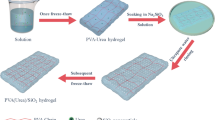Abstract
Freeze-extraction, which involves phase separation principle, gave highly porous scaffolds without the time and energy consuming freeze-drying process. The presented method eliminates the problem of formation of surface skin observed in freeze-drying methods. The effects of different freezing temperature (−80 and −24°C), medium (dry ice/ethanol bath and freezer) and polymer concentrations (1, 3, and 5 wt.%) on the scaffold properties were investigated in connection with the porous morphology and physicomechanical characteristics of the final scaffolds. The FESEM micrographs showed porous PLLA scaffolds with ladder-like architecture. The size of the longitudinal pores was in the range of 20–40 μm and the scaffolds had high porosity values ranging from 90% to 98%. Variation in porosity, mechanical resistance, and degree of regularity in the spatial organization of pores were observed when polymer concentration was changed. More open scaffold architecture with enhanced pore interconnectivity was achieved when a dry ice/ethanol bath of −80°C was used. Polymer concentration played an important role in fabricating highly porous scaffolds, with ladder-like architecture only appearing at polymer concentrations of above 3 wt.%. With the freeze-extraction method used here, highly porous and interconnected poly(l-lactide) scaffolds were successfully fabricated, holding great potential for tissue engineering applications.






Similar content being viewed by others
References
R. Langer, J.P. Vacanti, Science 260(5110), 920–926 (1993)
R.M. Nerem, A. Sambanis, Tissue Eng. 1(1), 3–13 (1995)
S.N. Bhatia, C.S. Chen, Biomed. Microdevice 2(2), 131–144 (1999)
P.X. Ma, Mater. Today 7(5), 30–40 (2004)
A.G. Mikos, A.J. Thorsen, L.A. Czerwonka, Y. Bao, R. Langer, Polymer 35(5), 1068–1077 (1994)
R.C. Thomson, M.J. Yaszemski, J.M. Powers, A.G. Mikos, Biomaterials 19(21), 1935–1943 (1998)
P.X. Ma, R. Zhang, J. Biomed. Mater. Res. 56(4), 469–477 (2001)
C. Schugens, V. Maquet, C. Grandfils, R. Jerome, P. Teyssie, J. Biomed. Mater. Res. 30, 449–461 (1996)
K. Whang, C.H. Thomas, K.E. Healy, Polymer 36(4), 837–842 (1995)
C. Schugens, V. Maquet, C. Grandfils, R. Jerome, P. Teyssie, Polymer 37(6), 1027–1038 (1996)
C. Tu, Q. Cai, J. Yang, Y. Wan, J. Bei, S. Wang, Polym. Adv. Technol. 14(8), 565–573 (2003)
M.H. Ho, P. Kuo, H. Hsieh, T. Hsien, L. Hou, J. Lai, D. Wang, Biomaterials 25(1), 129–138 (2004)
P.X. Ma, Mater. Today 7(5), 30–40 (2004)
P.X. Ma, in Scaffolding in Tissue Engineering (Taylor & Francis, 2006)
D.J. Mooney, D.F. Baldwin, N.P. Suht, J.P. Vacantis, R. Langer, Biomaterials 17(14), 1417–1422 (1996)
L.D. Harris, B.S. Kim, D.J. Mooney, J. Biomed. Mater. Res. 42(3), 396–402 (1998)
D.W. Hutmacher, T. Schantz, I. Zein, K.W. Ng, S.H. Teoh, K.C. Tan, J. Biomed. Mater. Res. 55(2), 203–216 (2001)
T.D. Roy, J.L. Simon, J.L. Ricci, E.D. Rekow, V.P. Thompson, J.R. Parsons, J. Biomed. Mater. Res. A 66(2), 283–291 (2003)
V.J. Chen, P.X. Ma, Biomaterials 25(11), 2065–2073 (2004)
R. Zhang, P.X. Ma, J. Biomed. Mater. Res. 52(2), 430–438 (2000)
S. Yang, K.F. Leong, Z. Du, C.K. Chua, Tissue Eng. 7(6), 679–689 (2001)
L.M. Pineda, M. Busing, R.P. Meinig, S. Gogolewskil, J. Biomed. Mater. Res. 31(3), 385–394 (1996)
J.H. Brauker, V.E. Carr-Brendel, L.A. Martinson, J. Crudele, W.D. Johnston, R.C. Johnson, J. Biomed. Mater. Res. 29(12), 1517–1524 (1995)
J.P. Fisher, T.A. Holland, D. Dean, P.S. Engel, A.G. Mikos, J. Biomater. Sci. Polym. Ed. 12(6), 673–687 (2001)
C.L. Jackson, M. T. Shaw, Polymer, 31(6), 1070–1084 (1990)
Author information
Authors and Affiliations
Corresponding author
Rights and permissions
About this article
Cite this article
Goh, Y.Q., Ooi, C.P. Fabrication and characterization of porous poly(l-lactide) scaffolds using solid–liquid phase separation. J Mater Sci: Mater Med 19, 2445–2452 (2008). https://doi.org/10.1007/s10856-008-3366-9
Received:
Accepted:
Published:
Issue Date:
DOI: https://doi.org/10.1007/s10856-008-3366-9




